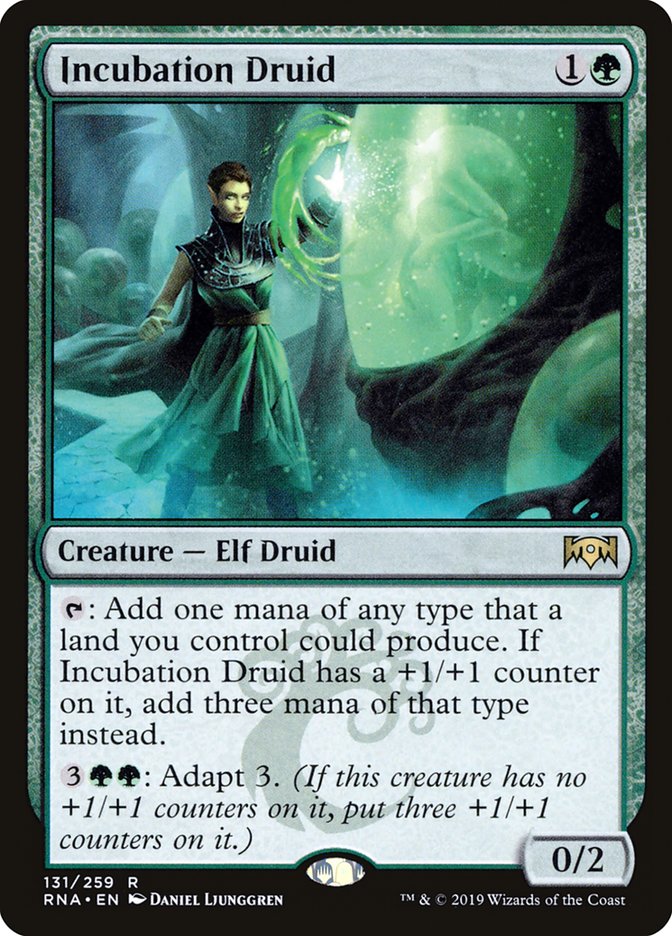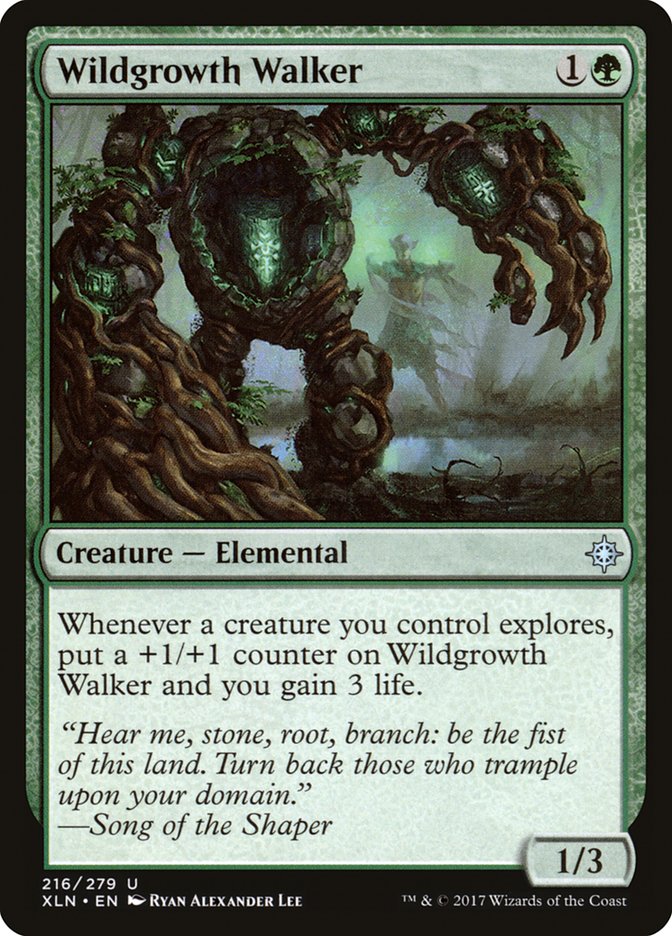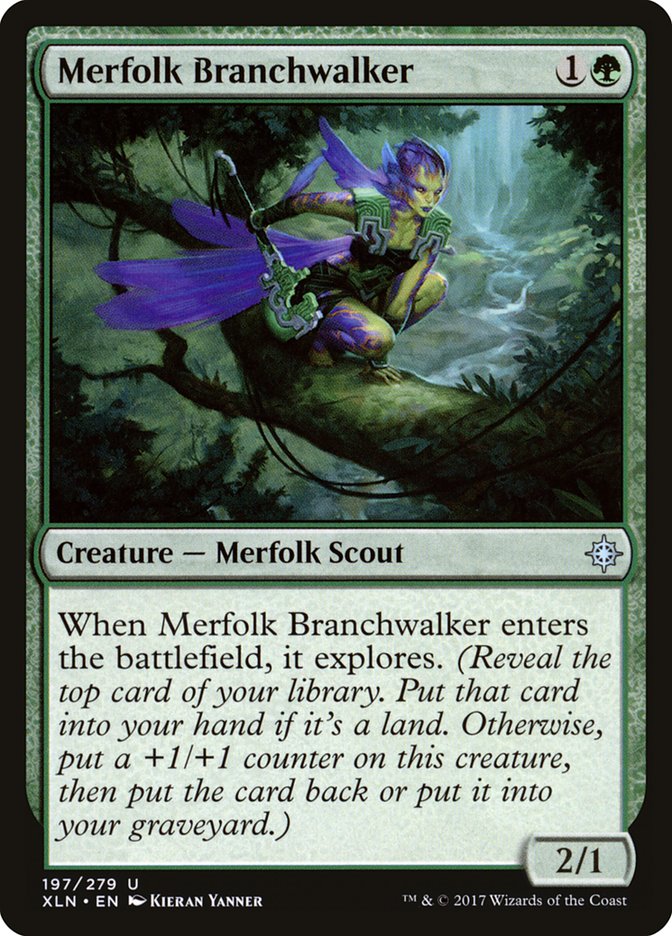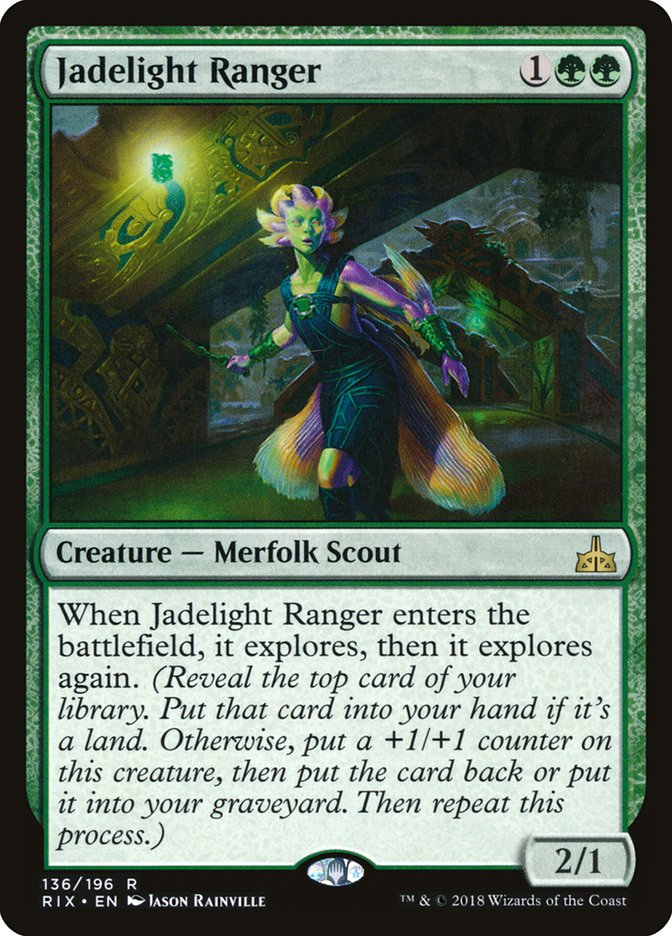Week one of Ravnica Allegiance is in the books, and SCG
Indianapolis did not disappoint. The newest set to join the ranks of
Standard had an enormous impact on decks both old and new, and the decks
that composed the Day 2 metagame were both interesting and diverse.
As for myself, I played Bant Nexus, a deck I
wrote about
last week leading up to the event, as it has been an archetype I was very
fond of all the way back last summer following the deck’s breakout at Pro
Tour 25th Anniversary. I took this list to a top 64 finish:
Planeswalkers (3)
Lands (25)
Spells (32)
- 4 Gift of Paradise
- 3 Search for Azcanta
- 2 Revitalize
- 4 Nexus of Fate
- 4 Root Snare
- 4 Chemister's Insight
- 2 Expansion
- 4 Growth Spiral
- 1 Precognitive Perception
- 4 Wilderness Reclamation
Sideboard

After a solid Day 1 followed by a disastrous Day 2, I still walked away
with what I think is a solid understanding of the beginnings of this
format. Today, I’m here to share some anecdotes, as well as break down what
worked and what didn’t for the players of the main event in Indianapolis
this past weekend.
The Hot
Creatures (26)
- 4 Llanowar Elves
- 2 Carnage Tyrant
- 4 Wildgrowth Walker
- 4 Merfolk Branchwalker
- 1 Seekers' Squire
- 4 Jadelight Ranger
- 2 Ravenous Chupacabra
- 2 Midnight Reaper
- 3 Hydroid Krasis
Planeswalkers (3)
Lands (24)
Spells (7)

Anthony Devarti, as well as many others, took the path of least resistance
this weekend by taking the best deck of Guilds of Ravnica Standard
and tossing in some Breeding Pools, Hydroid Krasis, and some counterspells.
The result was the definitively best performing deck of the weekend, as
well as the winning one, and solidifies the argument that sticking with a
known, working deck from the previous format is a solid plan. Let’s look at
the numbers:
- Copies in Day 2: 17
- Copies in Top 64: 17/17 (100%)
- Copies in Top 32: 8/17 (47%)
- Copies in Top 16: 5/17 (30%)
- Copies in Top 8: 2/17 (12%)
It’s important to note that for the Top 64 conversion rate, only 68 players
made Day 2 of the event, so this isn’t unreasonable. However, moving up,
almost half of the second day participants on the deck broke into the Top
32, over a quarter into the Top 16, and 12% of Sultai players turned a 7-2
or better record into a Top 8 berth. Out of those 17 players, 12 of them
(70%) posted a 10-5 or better finishing record.
Now, lumped into this group are some unique takes on the deck. The most
unique of all was Collins Mullen’s list he took to a 24th place finish:
Creatures (10)
Planeswalkers (2)
Lands (25)
Spells (23)
- 4 Opt
- 1 Search for Azcanta
- 2 Moment of Craving
- 2 Cast Down
- 4 Thought Erasure
- 2 Assassin's Trophy
- 4 Ritual of Soot
- 4 Growth Spiral
Sideboard

I played against Collins in Round 10, and have to say that I was very
impressed with the deck’s ability to disrupt using cards like Thought
Erasure, as well as using Growth Spiral to push towards the endgame of
Biogenic Ooze, Vraska, Relic Seeker, and Hydroid Krasis even sooner.
Biogenic Ooze has struck me as the card players have been sleeping on the
most-likely overshadowed by everyone’s favorite Jellyfish Hydra Beast. I
imagine that the Lotus Box group concluded that Ooze was one of the best
threats they could have against the other green midrange decks, which made
up the bulk of the Indianapolis metagame.
Other lists, dubbed Sultai Climb, made a bit more use of the namesake card,
Hadana’s Climb, to go, quite literally, over the top of their opponents’
creatures:
Creatures (23)
- 1 Carnage Tyrant
- 4 Wildgrowth Walker
- 4 Merfolk Branchwalker
- 4 Jadelight Ranger
- 2 Ravenous Chupacabra
- 4 Hydroid Krasis
- 4 Incubation Druid
Planeswalkers (3)
Lands (24)
Spells (10)

While adding two copies of Hadana’s Climb to the Golgari/Sultai explore
shell and calling it a day doesn’t strike me as a completely different
archetype, I appreciate the different angle of attack the card uses. It
makes one creature on its own much more powerful, as well as being
excellent in the mirror, since short of Hydroid Krasis, neither deck does
much flying (and since it only temporarily gives your creature flying, it
doesn’t get shot out of the air by Vivien Reid!).
One card I like in this deck that I believe Sultai Midrange players will
want to move to is Incubation Druid.
I would favor the player with Incubation Druid in their deck in these green
midrange mirrors over the one who doesn’t, as the mana advantage quickly
becomes too much to overcome; you’ll deploy your threats faster, your
Hydroid Krasises (Krasi?) will be bigger on average than theirs, and you’ll
be able to play a couple more expensive spells to make sure you’ll always
using all that mana (Biogenic Ooze, anyone?). I like Will’s take
on the deck, and I think this is where I’d like to tweak in an attempt to
hedge in the mirror.
The Lukewarm
One of the more interesting data points to me was how poor, by comparison,
Mono-Red Aggro performed in this tournament. It was the second most
represented deck in the Day 2 metagame, which is significant, but
typically, Mono-Red Aggro is the bogeyman of a week one Standard
tournament, as we all know it preys on players trying out new and exciting
decks that are, more than likely, not tuned. Let’s break down the
conversion rates for Mono Red Aggro as well:
- Copies in Day 2: 9
- Copies in Top 64: 9/9 (100%)
- Copies in Top 32: 5/9 (55%)
- Copies in Top 16: 2/9 (22%)
- Copies in Top 8: 0/9 (0%)
Right off the bat, we see that only half as many Mono-Red players even made
it to the second day of competition compared to Sultai Midrange. Again,
100% of the pilots in the second day cashed the main event, and a
comparable percentage of players made top 32 (slightly more at 55% versus
Sultai’s 47%), but that’s where the joy ride seemed to almost end. The two
players to crack top 16 in the event, Caleb Scherer and Julian John, are
veterans of the SCG Tour and players I would expect to perform well with
almost anything you handed them, which leads me to argue that a hefty
amount of the deck’s performance had, at least in some part, to do with the
pilots behind the deck. Of note, Caleb Scherer did finish with a 12-3
record, the same record as the fifth through eleventh place finishers,
which means that tiebreaker math did potentially prevent a copy of Mono-Red
from making the elimination rounds.
Now that we have the numbers, it’s important to talk about why Mono-Red, a
deck that, again, typically performs above average in the early weeks of a
Standard format, did much poorer than expected. Even aggro master Tom Ross
made the claim
that it would be the trophy winner this weekend! I have a pretty good guess
that there’s a bit of an inverse relationship between Mono-Red Aggro’s
performance and the exceptionally high presence of these cards in players’
decks this weekend:
Mono-Red Aggro made playing Sultai Midrange even more of a
“no-brainer” than it might already have been, as last format’s Golgari
Midrange deck was a big reason why the red decks fell flat on their face
for a majority of Guilds of Ravnica Standard. While the new tools
that red got, like Light Up the Stage and Skewer the Critics, did improve
the power level of the deck and give it a combination of speed and
consistency it didn’t have last format, a single unchecked Wildgrowth
Walker is an absolute nightmare for a deck full of two-power creatures and
burn spells, as a single explore trigger going off essentially counters an
entire burn spell aimed at the face. It also goes without saying that a red
deck’s least favorite toughness for their opponents’ creatures is anything
higher than three, something Wildgrowth Walker quickly outgrows if given
even a single turn to survive.
Combined with the fact that some of the other expected decks in the format,
like Esper Control, have moved to Absorb as their three-mana counterspell
of choice, it seems reasonable to say that the tools to fight the red
menace week one were there and easily slotted in without sacrificing too
much in other matchups.
Again, Mono-Red was the second most represented deck in the second day of
the Indianapolis Open. Its performance was by no means bad, but I
think the biggest takeaway from this is that, as I’ve mentioned before, the
early weeks of a format are typically the best time for lower powered red
aggressive decks to thrive.
Basically, it likely only gets worse from here. There’s no Glorybringer,
Hazoret the Fervent, and Chandra, Torch of Defiance-style card to give the
deck long-term staying power. The best red has is Experimental Frenzy, and
at this point, players are prepared for it.
Another deck that followed up Mono-Red was Esper Control. While it wasn’t
as heavily represented in Day 2 of the event, it actually ended up boasting
the highest Top 8 conversion rate, at 40%! Five pilots did battle on
Sunday, and this was the quick breakdown:
- Copies in Day 2: 5
- Copies in Top 64: 4/5 (8%)
- Copies in Top 32: 3/5 (60%)
- Copies in Top 16: 2/5 (40%)
- Copies in Top 8: 2/5 (40%)
Creatures (1)
Planeswalkers (4)
Lands (27)
Spells (28)

Esper Control ended up being the only other deck in the Top 8 of the Open
besides Sultai Midrange to put in two copies. This is exceptionally
impressive, given that, unlike Mono-Red Aggro, control decks typically are
much less popular early on in a format because it’s typically harder to
pinpoint an expected metagame. Giving a quick look at Nick Cowden’s
decklist, we see that the deck had a lot of very general answers to
problems. Absorb and Syncopate are non-conditional counterspells, and the
addition of Mortify gives Esper an incredibly flexible maindeck answer to
creatures that also has some utility in places like the mirror match or
against the Wilderness Reclamation decks, to deal with problematic
enchantments.
Additionally, the power level of some of the new cards from Ravnica Allegiance may have just been enough to give the deck
enough power to stand on its own. Kaya’s Wrath, Precognitive Perception,
and Teferi, Hero of Dominaria are extremely strong spells, and I imagine
the return of the four-mana sweeper allowing you to curve Kaya’s Wrath into
Teferi is incredibly difficult for some decks to overcome.
Perhaps this time around, the combination of the tools being there and an
easier to expect metagame is what gave Esper Control a solid showing. I
would imagine that the deck’s Day 2 representation is due to less players
playing it than actually making it to the second day of competition, so I
expect this deck to be a contender moving forward.
The Not
Planeswalkers (3)
Lands (25)
Spells (32)
- 4 Gift of Paradise
- 3 Search for Azcanta
- 2 Revitalize
- 4 Nexus of Fate
- 4 Root Snare
- 4 Chemister's Insight
- 2 Expansion
- 4 Growth Spiral
- 1 Precognitive Perception
- 4 Wilderness Reclamation
Sideboard

I hate to say it, but this deck was one of the biggest busts in terms of
performance in the Open.
Leading up to Indianapolis, many were talking about Wilderness Reclamation,
its bustedness, and how it would push Nexus of Fate decks to an unbeatable
force in the format. It’s one tournament, and fifteen rounds in a
tournament a final judgment on a deck does not make, but the various Nexus
of Fate decks that made it to Day 2 failed to convert well. Here’s the
breakdown:
- Copies in Day 2: 6
- Copies in Top 64: 6/6 (100%)
- Copies in Top 32: 0/6 (0%)
- Copies in Top 16: 0/6 (0%)
- Copies in Top 8: 0/6 (0%)
The highest place finish was for the deck was right outside of top 32 at
33rd place, 30 point (10-5 record) by Cain Rianhard, and the rest of the
pilots finished below that. Note, I did lump together the Bant versions of
the deck with the two Nexus of Gates pilots that also finished in top 64.
For reference, this was the highest placing Gates version of the deck:
Creatures (4)
Lands (26)
Spells (30)
- 4 Gift of Paradise
- 2 Search for Azcanta
- 4 Nexus of Fate
- 4 Guild Summit
- 2 Expansion
- 3 Circuitous Route
- 4 Growth Spiral
- 3 Wilderness Reclamation
- 4 Gates Ablaze
Sideboard

It’s possible that the best build of this deck has yet to be found. It’s
also possible that the deck fails to withstand the hate from players’
sideboards after the conclusion of the first game. I think time will tell,
but for the first week of the format, Nexus of Fate decks didn’t come very
close to dominating SCG Indianapolis. I do think that the deck is most
certainly a contender, but I believe the deck’s biggest goal will be
finding a suitable sideboard plan to win. I employed Hydroid Krasis in my
sideboard this weekend and found it to be quite good, but I don’t think
it’s the best, or perhaps only, thing Nexus decks can do.
The Others
It would be not doing my due diligence in my analysis of the first Standard
Open of Ravnica Allegiance without showcasing some of the other
delights of this new format that graced the top tables. One such deck was
quite the amalgamation of cards. Jonathan Hobbs ran all the way to the
finals of this past weekend’s main event with this masterpiece:
Creatures (13)
Planeswalkers (2)
Lands (26)
Spells (19)

I took this deck for a spin myself earlier in the week after the youngster
from Indiana posted on Twitter his decklist. I quickly found it difficult
to think that his claim of putting in many hours working on and tuning this
deck was not true, as the numbers of some of cards strikes me as extremely
calculated. So far, this is the most successful list to utilize the Angel
of Grace, one of the many powerful mythics printed in Ravnica Allegiance. Perhaps this is an archetype worth exploring
in this format, as the spell suite is full of some of the best that the
Bant colors have to offer. Perhaps this is a deck that could make use of
some number of copies of Wilderness Reclamation…
One of the other more interesting decks of the weekend was Pro Tour Dominaria champion Wyatt Darby’s Esper Midrange:
Creatures (22)
- 2 Hostage Taker
- 2 Lyra Dawnbringer
- 3 Thief of Sanity
- 4 Deputy of Detention
- 3 Seraph of the Scales
- 4 Basilica Bell-Haunt
- 4 Hero of Precinct One
Planeswalkers (2)
Lands (24)
Spells (12)

I personally hadn’t seen a ton of this deck myself, but I was aware that
Wyatt had been streaming this deck some over the course of last couple
weeks. The deck makes great use of a handful of new cards from Ravnica Allegiance and looks like it has all the tools to combat
just about anything in the format. Hero of Precinct One gives the deck the
ability to hit the ground running on the second turn of the game before
employing a healthy mix of interaction and other multicolored creatures to
grow an army of Human tokens.
From my scouring of decklists this weekend, it looks like Basilica
Bell-Haunt was quite possibly the most popular of the new cycle of XXYY
mana cost cards. The effect is very strong against Mono-Red Aggro by
providing the one, two, three punch of a four toughness body, a few extra
life points, and the discard effect. The maindeck Thief of Sanity and
Thought Erasure give the deck a very solid avenue to victory against the
slower decks of the format, especially Nexus of Fate style decks that have
few ways to stop Thief of Sanity from stealing their cards. I expect a deck
like this to be quite popular in the immediate future.
Finally, Mason Clark brought to the table a unique take of a
Guildgate-centric deck. Of note, it was devoid of seven mana Time Walks,
instead looking to win the game with Gateway Colossus, Hydroid Krasis, and
Gatebreaker Rams.
Creatures (11)
Lands (27)
Spells (22)

I have been nothing but impressed with how powerful the “Gates matter”
cards from Ravnica Allegiance are, even for Constructed level
play. I plan to watch closely to see if these decks can reach an iteration
capable of being a dominant force in Standard.
What’s Next?
Ravnica Allegiance
had one heck of a showing for the first week of Standard. A lot of the old
mixed in with a lot of the new, but one thing was certain for every deck we
saw; Ravnica Allegiance already has left an enormous mark on the
format, and the base has been set for the arms race to find the most tuned
version of what we saw this past weekend.
While SCG Indianapolis was the
premier paper event for Standard this weekend, an online Mythic
Championship Qualifier took place that painted a very different picture,
with three decks featuring Nexus of Fate reaching the elimination rounds.
Before I wrap things up here, I just want to make a note about the data
presented in this article today. It’s important to not take information
like this at face value when attempting to dissect what worked and what
didn’t this weekend. Beyond the numbers, there’s a ton of missing context
to each and every one of them. For example, it’s reasonable to assume that
Sultai Midrange and Mono-Red Aggro were the two most registered decks for
the tournament of 691, which likely attributed to larger Day 2
representation.
What will the format look like after we leave SCG Baltimore and head into
the Dallas Open in a couple weeks? Only time will tell.





